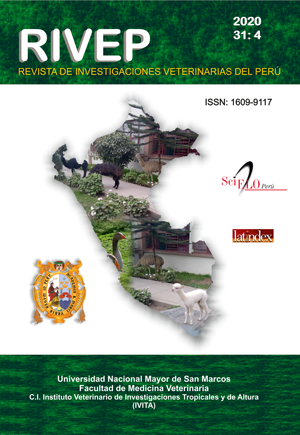Blastocystosis and other intestinal infections by eukaryotic parasites of Gallus gallus domesticus in localities of southern Chile
DOI:
https://doi.org/10.15381/rivep.v31i4.19041Keywords:
Blastocystis, faeces, hens, humans, intestinal parasitesAbstract
The purpose of this investigation was to determine the presence and prevalence of blastocystosis, a zoonosis caused by Blastocystis sp in free-range hens in homes of different localities in southern Chile, simultaneously verify human infection in at least one locality, and identify other infections by intestinal parasites in birds. Fresh fecal samples from hens and humans were collected and preserved in PAF fixative and processed by the PAFS method combined with a flotation phase with zinc sulfate solution. Blastocystis sp was detected in half of the homes and the average prevalence was 14.2% in the total of localities being greater in the rural area and in the locality of Teupa (p<0.05). The prevalence in humans was higher than in hens in the town of Ñancul (p<0.05), where the parasite was present in both hosts in 4 of 7 households. The prevalence of infection by Entamoeba gallinarum and the presence of Toxocara spp eggs was similar between localities, but the prevalences of Eimeria spp, Capillariidae gen. spp and Heterakis gallinarum / Ascaridia galli showed differences between localities (p<0.05). Only in Valdivia were observed samples with eggs of Trichostrongylidae gen. spp. The presence of blastocystosis in chicken was detected for the first time in Chile, suggesting its potential transmission to humans. The presence of Toxocara spp eggs in bird faeces suggests that they could act as environmental dispersers.
Downloads
Downloads
Published
Issue
Section
License
Copyright (c) 2020 Patricio Torres, Omar Cerna, Alonso Rubilar, Álvaro Subiabre, Pablo Oyarzún

This work is licensed under a Creative Commons Attribution-NonCommercial-ShareAlike 4.0 International License.
AUTHORS RETAIN THEIR RIGHTS:
a. Authors retain their trade mark rights and patent, and also on any process or procedure described in the article.
b. Authors retain their right to share, copy, distribute, perform and publicly communicate their article (eg, to place their article in an institutional repository or publish it in a book), with an acknowledgment of its initial publication in the Revista de Investigaciones Veterinarias del Perú (RIVEP).
c. Authors retain theirs right to make a subsequent publication of their work, to use the article or any part thereof (eg a compilation of his papers, lecture notes, thesis, or a book), always indicating the source of publication (the originator of the work, journal, volume, number and date).



